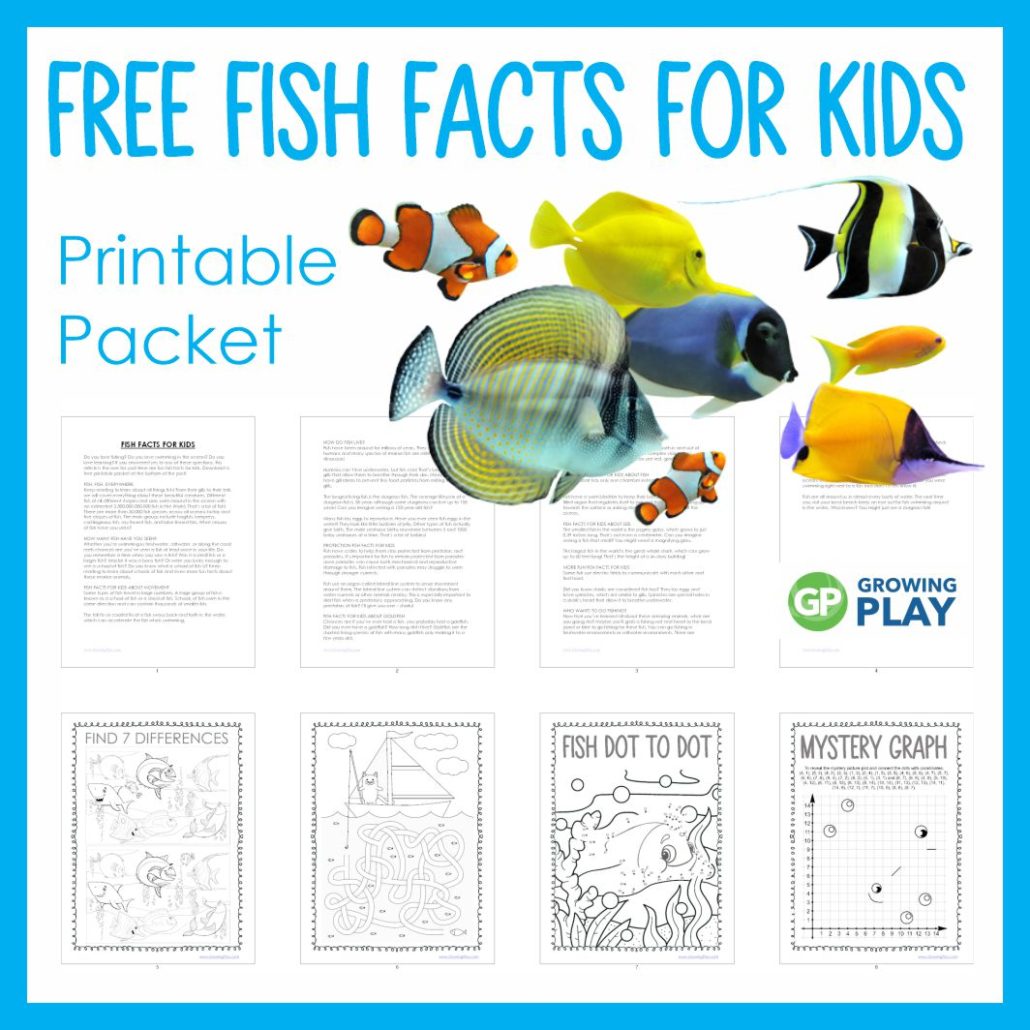Fish Facts for Kids

Do you love fishing? Do you love swimming in the ocean? Do you love learning? If you answered yes to any of these questions, this article is the one for you! Here are fun fish facts for kids. Download a free printable packet at the bottom of the post! Read the facts, find the differences, do the fishing maze, complete the dot to dot fish puzzle, and solve the mystery graph! ALL ABOUT FISH in one handy printable.
Fish, Fish, Everywhere
Keep reading to learn about all things fish! From their gills to their tails we will cover everything about these beautiful creatures. Different fish of all different shapes and sizes swim around in the ocean with an estimated 3,500,000,000,000 fish in the World. That’s a lot of fish! There are more than 30,000 fish species across all oceans today and five classes of fish. The main groups include hagfish, lampreys, cartilaginous fish, ray-finned fish, and lobe-finned fish. What classes of fish have you seen?
How Many Fish Have you Seen?
Whether you’re swimming in freshwater, saltwater, or along the coral reefs chances are you’ve seen a fish at least once in your life. Do you remember a time when you saw a fish? Was it a small fish or a larger fish? Maybe it was a bony fish? Or were you lucky enough to see a school of fish? Do you know what a school of fish is? Keep reading to learn about schools of fish and even more fun facts about these marine animals.
Fish Facts for Kids About Movement
Some types of fish travel in large numbers. A large group of fish is known as a school of fish or a shoal of fish. Schools of fish swim in the same direction and can contain thousands of smaller fish.
The tail fin or caudal fin of a fish sways back and forth in the water, which can accelerate the fish when swimming.
Pixel Art Color By Number – Animal Edition
How do Fish Live?
Fish have been around for millions of years. They are older than humans and many species of marine fish are older than the dinosaurs!
Humans can’t live underwater, but fish can! That’s because fish have gills that allow them to breathe through their skin. Many fish also have gill rakers to prevent tiny food particles from exiting through the gills.
The longest living fish is the sturgeon fish. The average lifespan of a sturgeon fish is 55 years although some sturgeons can live up to 155 years! Can you imagine seeing a 155-year-old fish?
Many fish lay eggs to reproduce. Have you ever seen fish eggs in the water? They look like little bubbles of jelly. Other types of fish actually give birth. The male seahorse births anywhere between 5 and 1000 baby seahorses at a time. That’s a lot of babies!
Protection Fish Facts for Kids
Fish have scales to help them stay protected from predators and parasites. It’s important for fish to remain protected from parasites since parasites can cause both mechanical and reproductive damage to fish. Fish infected with parasites may struggle to swim through stronger currents.
Fish use an organ called lateral line system to sense movement around them. The lateral line system can detect vibrations from water currents or other animals nearby. This is especially important to alert fish when a predator is approaching. Do you know any predators of fish? I’ll give you one – sharks!
Fish Facts for Kids About Goldfish
Chances are if you’ve ever had a fish, you probably had a goldfish. Did you ever have a goldfish? How long did it live? Goldfish are the shortest living species of fish with many goldfish only making it to a few years old.
Goldfish are one of the only fish that can see both in and out of water. Goldfish have some of the most complex vision when compared to other animals. They can see red, green, blue, and ultraviolet light.
Interesting Facts for Kids About Fish
A fish’s heart has only one chamber instead of four like a human does.
Fish have a swim bladder to keep their body in balance. This is a gas-filled organ that regulates itself to prevent the fish from floating up towards the surface or sinking down towards the bottom of the ocean.

Mandala Mazes
Fish Facts for Kids About Size
The smallest fish in the world is the pygmy goby, which grows to just 0.39 inches long. That’s not even a centimeter. Can you imagine seeing a fish that small? You might need a magnifying glass.
The largest fish in the world is the great whale shark, which can grow up to 60 feet long! That’s the height of a six-story building!
More Fun Fish Facts for Kids
Some fish use electric fields to communicate with each other and find food.
Did you know sharks are considered fish too? They lay eggs and have spiracles, which are similar to gills. Spiracles are special holes in a shark’s head that allow it to breathe underwater.
Who Wants to go Fishing?
Now that you’ve learned all about these amazing animals, what are you going do? Maybe you’ll grab a fishing rod and head to the local pond or lake to go fishing for these fish. You can go fishing in freshwater environments or saltwater environments. There are different kinds of fish in each environment, so make sure you check them both out if you can!
Swimming, anyone?
You can also go swimming in most fresh water and salt water areas. Lakes and ponds tend to be filled with fresh water and salt water is mainly found in oceans. Have you ever been to a lake, a pond, an ocean, or all three? Did you go swimming? Chances are you were swimming right next to a fish and didn’t even know it!
Fish are all around us in almost every body of water. The next time you visit your local beach keep an eye out for fish swimming around in the water. Who knows? You might just see a sturgeon fish!
HOW TO ACCESS FREE FISH FACTS FOR KIDS ACTIVITIES!!!!
1. Sign up to receive the weekly newsletter and other announcements from Growing Play at the bottom of this post. If you already subscribe, just enter your email and you will get access to the freebie too!
2. Download the fun and FREE fish printables!
3. Read the facts, find the differences, do the fishing maze, complete the dot to dot fish puzzle, and solve the mystery graph! ALL ABOUT FISH!

WANT MORE FUN FACTS FOR KIDS?
Check 100 fun facts for kids here and browse all the other topics at the bottom of the post.


